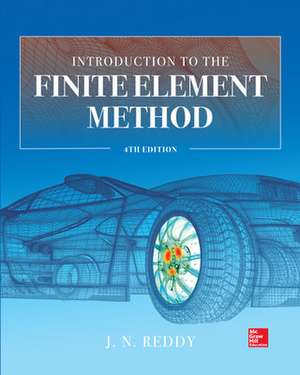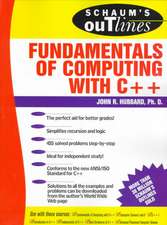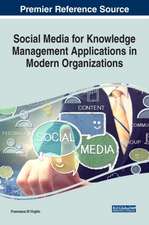Introduction to the Finite Element Method 4E
Autor J. Reddyen Limba Engleză Hardback – 16 noi 2018
An up-to-date, self-contained introduction to the theory and applications of the finite element method
This thoroughly revised classic engineering textbook offers a broad-based overview of the finite element method. Written by a world-renowned mechanical engineering researcher and author, the book shows, step-by-step, how to calculate numerical solutions to steady-state as well as time-dependent problems. You also get detailed problems with worked-out solutions and downloadable programs that can be used and modified for real-world situations. Special attention is paid to applications that are important in bioengineering, fluid and thermal sciences, structural mechanics, and a host of applied sciences.
Introduction to the Finite Element Method, Fourth Edition, covers:
• Mathematical preliminaries and classical variational methods
• 1-D finite element models of second-order differential equations
• Applications to 1-D heat transfer and fluid and solid mechanics problems
• Finite element analysis of beams and circular plates
• Plane trusses and frames
• Eigenvalue and time-dependent problems in 1-D
• Numerical integration and computer implementation in 1-D
• Single-variable problems in two dimensions
• 2-D interpolation functions, numerical integration, and computer implementation in 2-D
• Flows of viscous incompressible fluids
• Plane elasticity
• 3-D finite element analysis
Preț: 1256.05 lei
Preț vechi: 1825.64 lei
-31% Nou
Puncte Express: 1884
Preț estimativ în valută:
240.37€ • 249.53$ • 200.43£
240.37€ • 249.53$ • 200.43£
Carte tipărită la comandă
Livrare economică 21 martie-01 aprilie
Preluare comenzi: 021 569.72.76
Specificații
ISBN-13: 9781259861901
ISBN-10: 1259861902
Pagini: 816
Dimensiuni: 211 x 262 x 46 mm
Greutate: 1.65 kg
Ediția:4
Editura: McGraw Hill Education
Colecția McGraw-Hill
Locul publicării:United States
ISBN-10: 1259861902
Pagini: 816
Dimensiuni: 211 x 262 x 46 mm
Greutate: 1.65 kg
Ediția:4
Editura: McGraw Hill Education
Colecția McGraw-Hill
Locul publicării:United States
Cuprins
1 General Introduction
1.1 Background
1.2 Mathematical Model Development
1.3 Numerical Simulations
1.4 The Finite Element Method
1.5 The Present Study
1.6 Summary
Problems
References for Additional Reading
2 Mathematical Preliminaries and Classical Variational Methods
2.1 General Introduction
2.2 Some Mathematical Concepts and Formulae
2.3 Energy and Virtual Work Principles
2.4 Integral Formulations of Differential Equations
2.5 Variational Methods
2.6 Equations of Continuum Mechanics
2.7 Summary
Problems
References for Additional Reading
3 1-D Finite Element Models of Second-Order Differential Equations
3.1 Introduction
3.2 Finite Element Analysis Steps
3.3 Finite Element Models of Discrete Systems
3.4 Finite Element Models of Continuous Systems
3.5 Axisymmetric Problems
3.6 Errors in Finite Element Analysis
3.7 Summary
Problems
References for Additional Reading
4 Applications to 1-D Heat Transfer and Fluid and Solid
Mechanics Problems
4.1 Preliminary Comments
4.2 Heat Transfer
4.3 Fluid Mechanics
4.4 Solid and Structural Mechanics
4.5 Summary
Problems
References for Additional Reading
5 Finite Element Analysis of Beams and Circular Plates
5.1 Introduction
5.2 Euler–Bernoulli Beam Element
5.3 Timoshenko Beam Elements
5.4 Axisymmetric Bending of Circular Plates
5.5 Summary
Problems
References for Additional Reading
6 Plane Trusses and Frames
6.1 Introduction
6.2 Analysis of Trusses
6.3 Analysis of Plane Frame Structures
6.4 Inclusion of Constraint Conditions
6.5 Summary
Problems
References for Additional Reading
7 Eigenvalue and Time-Dependent Problems in 1-D
7.1 Introduction
7.2 Equations of Motion
7.3 Eigenvalue Problems
7.4 Transient Analysis
7.5 Summary
Problems
References for Additional Reading
8 Numerical Integration and Computer Implementation
8.1 Introduction
8.2 Numerical Integration
8.3 Computer Implementation
8.4 Applications of Program FEM1D
8.5 Summary
Problems
References for Additional Reading
9 Single-Variable Problems in Two Dimensions
9.1 Introduction
9.2 Boundary Value Problems
9.3 Modeling Considerations
9.4 Numerical Examples
9.5 Eigenvalue and Time-Dependent Problems
9.6 Summary
Problems
References for Additional Reading
10 2-D Interpolation Functions, Numerical Integration, and Computer Implementation
10.1 Introduction
10.2 2-D Element Library
10.3 Numerical Integration
10.4 Modeling Considerations
10.5 Computer Implementation and FEM2D
10.6 Summary
Problems
References for Additional Reading
11 Flows of Viscous Incompressible Fluids
11.1 Introduction
11.2 Governing Equations
11.3 Velocity–Pressure Formulation
11.4 Penalty Function Formulation
11.5 Computational Aspects
11.6 Numerical Examples
11.7 Summary
Problems
References for Additional Reading
12 Plane Elasticity
12.1 Introduction
12.2 Governing Equations
12.3 Virtual Work and Weak Formulations
12.4 Finite Element Model
12.5 Elimination of Shear Locking in Linear Elements
12.6 Numerical Examples
12.7 Summary
Problems
References for Additional Reading
13 3-D Finite Element Analysis
13.1 Introduction
13.2 Heat Transfer
13.3 Flows of Viscous Incompressible Fluids
13.4 Elasticity
13.5 Element Interpolation Functions and Numerical Integration
13.6 Numerical Examples
13.7 Summary
Problems
References for Additional Reading
Index
1.1 Background
1.2 Mathematical Model Development
1.3 Numerical Simulations
1.4 The Finite Element Method
1.5 The Present Study
1.6 Summary
Problems
References for Additional Reading
2 Mathematical Preliminaries and Classical Variational Methods
2.1 General Introduction
2.2 Some Mathematical Concepts and Formulae
2.3 Energy and Virtual Work Principles
2.4 Integral Formulations of Differential Equations
2.5 Variational Methods
2.6 Equations of Continuum Mechanics
2.7 Summary
Problems
References for Additional Reading
3 1-D Finite Element Models of Second-Order Differential Equations
3.1 Introduction
3.2 Finite Element Analysis Steps
3.3 Finite Element Models of Discrete Systems
3.4 Finite Element Models of Continuous Systems
3.5 Axisymmetric Problems
3.6 Errors in Finite Element Analysis
3.7 Summary
Problems
References for Additional Reading
4 Applications to 1-D Heat Transfer and Fluid and Solid
Mechanics Problems
4.1 Preliminary Comments
4.2 Heat Transfer
4.3 Fluid Mechanics
4.4 Solid and Structural Mechanics
4.5 Summary
Problems
References for Additional Reading
5 Finite Element Analysis of Beams and Circular Plates
5.1 Introduction
5.2 Euler–Bernoulli Beam Element
5.3 Timoshenko Beam Elements
5.4 Axisymmetric Bending of Circular Plates
5.5 Summary
Problems
References for Additional Reading
6 Plane Trusses and Frames
6.1 Introduction
6.2 Analysis of Trusses
6.3 Analysis of Plane Frame Structures
6.4 Inclusion of Constraint Conditions
6.5 Summary
Problems
References for Additional Reading
7 Eigenvalue and Time-Dependent Problems in 1-D
7.1 Introduction
7.2 Equations of Motion
7.3 Eigenvalue Problems
7.4 Transient Analysis
7.5 Summary
Problems
References for Additional Reading
8 Numerical Integration and Computer Implementation
8.1 Introduction
8.2 Numerical Integration
8.3 Computer Implementation
8.4 Applications of Program FEM1D
8.5 Summary
Problems
References for Additional Reading
9 Single-Variable Problems in Two Dimensions
9.1 Introduction
9.2 Boundary Value Problems
9.3 Modeling Considerations
9.4 Numerical Examples
9.5 Eigenvalue and Time-Dependent Problems
9.6 Summary
Problems
References for Additional Reading
10 2-D Interpolation Functions, Numerical Integration, and Computer Implementation
10.1 Introduction
10.2 2-D Element Library
10.3 Numerical Integration
10.4 Modeling Considerations
10.5 Computer Implementation and FEM2D
10.6 Summary
Problems
References for Additional Reading
11 Flows of Viscous Incompressible Fluids
11.1 Introduction
11.2 Governing Equations
11.3 Velocity–Pressure Formulation
11.4 Penalty Function Formulation
11.5 Computational Aspects
11.6 Numerical Examples
11.7 Summary
Problems
References for Additional Reading
12 Plane Elasticity
12.1 Introduction
12.2 Governing Equations
12.3 Virtual Work and Weak Formulations
12.4 Finite Element Model
12.5 Elimination of Shear Locking in Linear Elements
12.6 Numerical Examples
12.7 Summary
Problems
References for Additional Reading
13 3-D Finite Element Analysis
13.1 Introduction
13.2 Heat Transfer
13.3 Flows of Viscous Incompressible Fluids
13.4 Elasticity
13.5 Element Interpolation Functions and Numerical Integration
13.6 Numerical Examples
13.7 Summary
Problems
References for Additional Reading
Index















